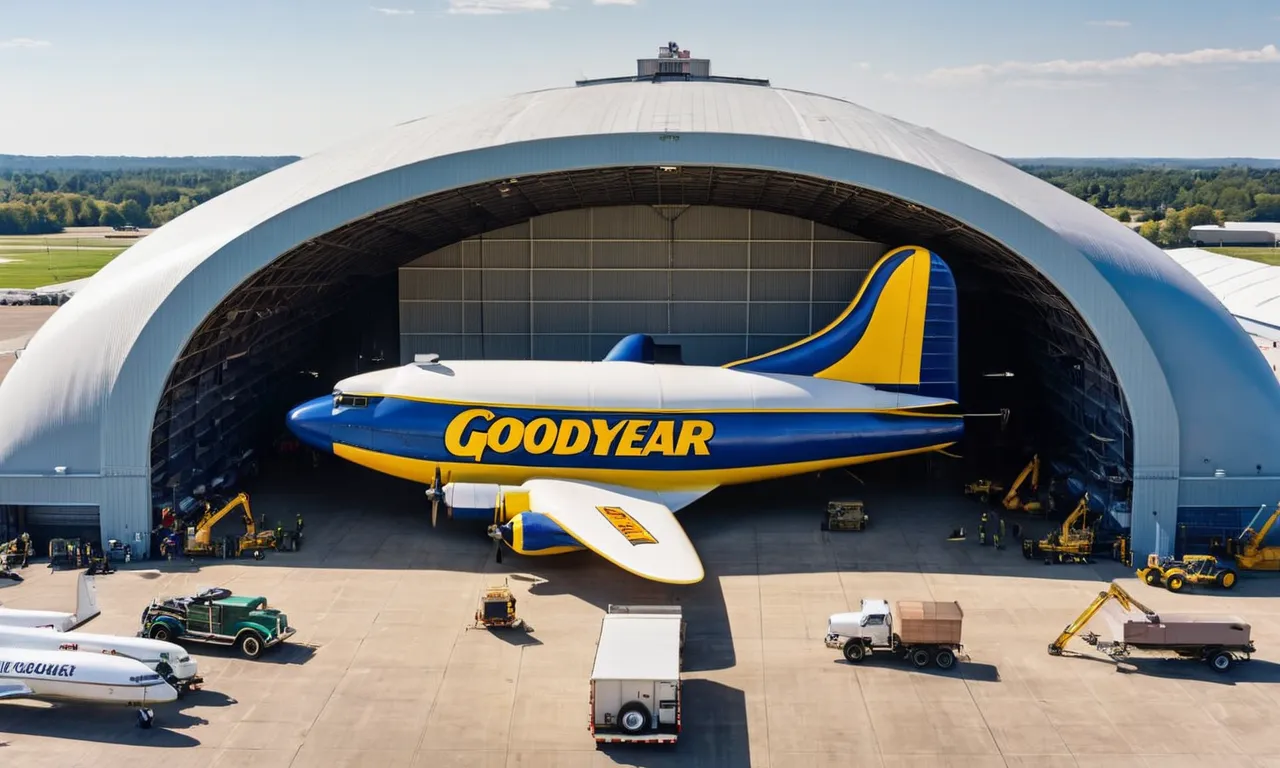Where Is The Goodyear Blimp Stored?
The iconic Goodyear blimp is recognized around the world as it flies over sporting events and noteworthy locations. But where does it live when it’s not patrolling the skies? If you’re short on time, here’s a quick answer: The Goodyear blimps are stored in hangars when not in use in Akron, Ohio, Carson, California, and Pompano Beach, Florida.
In this comprehensive guide, we will cover everything you need to know about where the Goodyear blimps are stored and maintained year-round. We’ll explore the blimp’s history, its three current U.S. base locations, details on the storage facilities and processes, and more.
History of the Goodyear Blimp
The Goodyear Blimp has become an iconic symbol in the sky, captivating audiences with its presence and unique advertising capabilities. Let’s take a journey through the history of the Goodyear Blimp and explore its evolution over the years.
Origins and Early Models
The story of the Goodyear Blimp begins in the early 1920s when the Goodyear Tire and Rubber Company was looking for innovative ways to promote their brand. The company decided to venture into the world of aviation and commissioned the construction of their first blimp, the Pilgrim, in 1925.
The early models of the Goodyear Blimp were relatively small and had limited capabilities. They were primarily used for advertising purposes, displaying the Goodyear logo and flying over major sporting events, concerts, and other high-profile gatherings.
These blimps were filled with non-flammable helium gas, making them safe and reliable for extended flights.
Over the years, Goodyear continued to refine and improve their blimps, incorporating technological advancements and expanding their fleet to meet the growing demand for aerial advertising.
Expansion During the Golden Age
The Goodyear Blimp experienced significant growth during the “Golden Age” of blimps, which spanned from the 1930s to the 1950s. This period marked a time of increased popularity and widespread use of blimps for various purposes, including military surveillance, passenger transportation, and advertising.
Goodyear took full advantage of this era by expanding their blimp fleet and introducing larger models that could carry more passengers and cargo. The introduction of the Goodyear GZ-20 model in the 1960s marked a significant milestone in the company’s history, as it became the standard design for Goodyear blimps for several decades.
During this time, the Goodyear Blimp became a familiar sight at major sporting events, providing aerial coverage and capturing breathtaking views for television broadcasts. The blimps also served as ambassadors for the Goodyear brand, showcasing its commitment to innovation and excellence.
Modern Blimp Models
Today, the Goodyear Blimp continues to evolve with the introduction of modern blimp models that incorporate the latest advancements in technology and design. The current fleet includes the Goodyear NT (New Technology) blimps, which feature a state-of-the-art semi-rigid structure and advanced avionics systems.
These modern blimps offer improved maneuverability, increased speed, and enhanced passenger comfort. They are equipped with high-definition cameras and broadcasting equipment, allowing for stunning aerial footage and live coverage of major events.
The Goodyear Blimp has also embraced environmentally-friendly practices by using LED lighting systems and more fuel-efficient engines, reducing its carbon footprint and promoting sustainability.
To this day, the Goodyear Blimp remains an iconic symbol in the sky, captivating audiences around the world with its majestic presence and serving as a testament to Goodyear’s commitment to innovation and excellence.
Year-Round Blimp Bases
Goodyear has several year-round blimp bases located across the United States. These bases serve as the primary storage and maintenance facilities for their iconic blimps. Let’s take a closer look at some of these bases:
Goodyear Air Dock, Akron, Ohio
The Goodyear Air Dock in Akron, Ohio is one of the most well-known blimp bases in the world. This historic facility, which dates back to the 1920s, is where the Goodyear Blimp was first manufactured. Today, it serves as a storage and maintenance hangar for the company’s fleet of blimps.
The Goodyear Air Dock is an impressive structure, measuring an incredible 1,175 feet long and 325 feet wide. It can accommodate multiple blimps at once, providing ample space for maintenance, repairs, and storage.
This base is a hub of activity, with technicians and crew members working diligently to ensure that the blimps are in top condition.
Carson, California Facility
In addition to the Goodyear Air Dock in Akron, Ohio, Goodyear also has a blimp base located in Carson, California. This facility serves as a strategic location to cover events and activities on the West Coast.
The Carson facility is equipped with a hangar that can house multiple blimps. It provides the necessary infrastructure and resources for the maintenance and storage of the blimps when they are not in use.
From this base, the Goodyear Blimp can easily travel to various locations in California and beyond to provide aerial coverage and advertising opportunities.
Pompano Beach, Florida Hangar
Another key blimp base for Goodyear is located in Pompano Beach, Florida. This hangar serves as a storage and maintenance facility for the blimps that operate in the southeastern region of the United States.
The Pompano Beach hangar is strategically positioned to cover events and activities in Florida and nearby states. From here, the Goodyear Blimp can provide stunning aerial shots and deliver messages to audiences attending major sporting events, concerts, and other gatherings.
These year-round blimp bases play a crucial role in the operations of the Goodyear Blimp. They provide the necessary infrastructure and resources for maintenance, repairs, and storage, ensuring that the blimps are always ready for their next aerial adventure.
Inside the Storage Hangars
When the Goodyear Blimp is not soaring through the sky, it finds its temporary home inside the storage hangars. These hangars are specifically designed to accommodate the massive size of the blimp and provide a safe and controlled environment for maintenance and storage purposes.
Structural Design and Layout
The storage hangars for the Goodyear Blimp are meticulously designed to cater to the unique needs of these iconic airships. They are typically large, spacious structures with high ceilings and wide openings to allow easy access for the blimps.
The hangars are constructed using sturdy materials and reinforced support systems to ensure the safety and stability of the blimps while they are stored.
Inside the hangars, you will find a carefully planned layout that maximizes the use of space. The blimps are parked in designated areas, allowing for efficient movement and maintenance procedures. The layout also includes storage areas for equipment and spare parts, ensuring that everything is easily accessible when needed.
Maintenance Work and Procedures
Regular maintenance is crucial to keep the Goodyear Blimps in top-notch condition. Inside the storage hangars, skilled technicians perform a wide range of maintenance tasks, including inspections, repairs, and upgrades.
These procedures help to ensure that the blimps are safe and ready to take to the skies when called upon.
Specialized equipment and tools are used during maintenance work, which can range from routine checks to more extensive repairs. The hangars provide a controlled environment, free from external elements that could potentially affect the maintenance process.
This controlled environment allows technicians to work efficiently and effectively.
Storage and Security Features
The storage hangars are equipped with various features to ensure the security and protection of the Goodyear Blimps. Advanced security systems, including surveillance cameras and access control measures, are in place to prevent unauthorized access and protect the valuable assets inside.
Additionally, the hangars are designed to protect the blimps from adverse weather conditions. These structures shield the blimps from rain, wind, and other elements that could potentially cause damage.
Climate control systems are also implemented to maintain optimal temperature and humidity levels, which are crucial for preserving the blimps’ integrity.
Transporting the Blimps
Ground Transportation Process
Transporting the Goodyear Blimps from one location to another requires careful planning and coordination. These iconic airships are too large to be flown like traditional aircraft, so they are transported on the ground using specialized vehicles.
The blimps are deflated and carefully packed into trailers, which are then attached to trucks for transportation.
The ground transportation process involves a team of experienced professionals who ensure that the blimps are secured properly and protected from any potential damage. The trailers used to transport the blimps are equipped with climate control systems to maintain the ideal temperature and humidity levels.
During the ground transportation process, the blimps are accompanied by a support crew that monitors the condition of the blimps and ensures their safe arrival at the designated location. This crew is responsible for handling any unexpected situations that may arise during the journey.
Crews and Specialized Equipment
The transportation of the Goodyear Blimps requires specialized equipment and highly skilled crews. The trailers used to transport the blimps are specifically designed to accommodate the unique shape and size of the airships.
These trailers are equipped with hydraulic systems that allow for smooth loading and unloading of the blimps.
Transporting the blimps also requires the use of specialized vehicles and towing equipment. These vehicles are equipped with powerful engines and advanced braking systems to ensure a safe and efficient transportation process.
The crews involved in the transportation process undergo extensive training to ensure that they have the necessary skills and knowledge to handle the blimps with care. They are trained in various aspects of blimp transportation, including securing the blimps, operating the specialized equipment, and handling emergency situations.
For more detailed information about the transportation process and the specialized equipment used, you can visit the Goodyear Blimp website.
Conclusion
The Goodyear blimp is an iconic piece of aviation history. When not flying over sporting events and providing aerial coverage, the blimps are housed in customized storage hangars in Akron, Carson, and Pompano Beach.
These state-of-the-art facilities not only store the aircraft, but serve as year-round bases facilitating blimp operations across the country. Specially designed for safely housing blimps long-term, they enable rigorous inspection and maintenance work to keep the aircraft flight-ready.
So the next time you see the Goodyear blimp coasting gracefully overhead, know it has a cozy hangar home awaiting its return!








